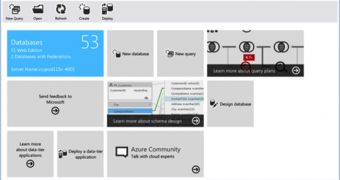In addition to announcing a series of changes performed to the Windows Azure website, complemented by the availability of new developer tools, Microsoft also announced the availability of the SQL Azure Q4 Service Release.
Officially introduced back in October at the PASS Summit, the SQL Azure Q4 Service Release brings along increased flexibility when it comes to scaling on demand, while also simplifying the monitoring and management of databases.
One of the main enhancements that the new SQL Azure Q4 Service Release brings along is the increase of the maximum database size threefold to 150 GB.
At the same time, Microsoft stresses on the fact that the setup, management, and automation of shards have been significantly simplified through the introduction of SQL Azure Federation.
The increase in database size also brings along a price cap, which was meant to result in lower effective cost per GB for those customers who manage large DBs.
The maximum price for SQL Azure DB is $499.95, effective Monday, December 12th. This means that all customers who have DBs of 50GB or larger can grow them without experiencing an increase in costs.
Microsoft notes that the effective price per GB will drop by 67 percent for those customers who use 150 GB databases.
According to the Redmond-based company, the upgrade to the SQL Azure Q4 Service Release should not affect user queries and existing applications. All these are expected to function normally during the transition.
The most notable changes in this release include:
- Increased maximum database size: As indicated above, the maximum database size for individual SQL Azure databases has been expanded 3x from 50 GB to 150 GB with the maximum aggregate charge per database per month capped at $499.95.
- SQL Azure Federation: With database federations, databases can be elastically scaled out using sharding based on database size and application workload. This new feature makes it dramatically easier to set up the sharding database pattern, automate the process of adding new shards, and provides significant new functionality for easily managing database shards.
- Refreshed SQL Azure Management Portal: The new portal has a Metro-style user interface with new features including new workspaces with the ability to more easily monitor databases, drill-down into schemas, query plans, spatial data, indexes/keys, and query performance statistics (see screen shots below). The new portal also supports SQL Azure Federation.
- Updated DAC Import/Export Service CTP: The service has been updated to address several issues since its initial release in the last SQL Azure service release. Customers can use this free service from the new management portal to easily import and export their database between SQL Azure and Windows Azure BLOB storage.
- Expanded support for user-controlled collations: When creating a database, users can now specify which collation to use. Users can specify all valid collations returned from the fn_helpcollations() system function. This function is now enabled in SQL Azure.
In the coming days, the company plans on offering additional details on the capabilities that have been included in the recently refreshed SQL Azure Management Portal. Moreover, info on the use of the new SQL Azure Federation feature is also set to emerge soon.

 14 DAY TRIAL //
14 DAY TRIAL //